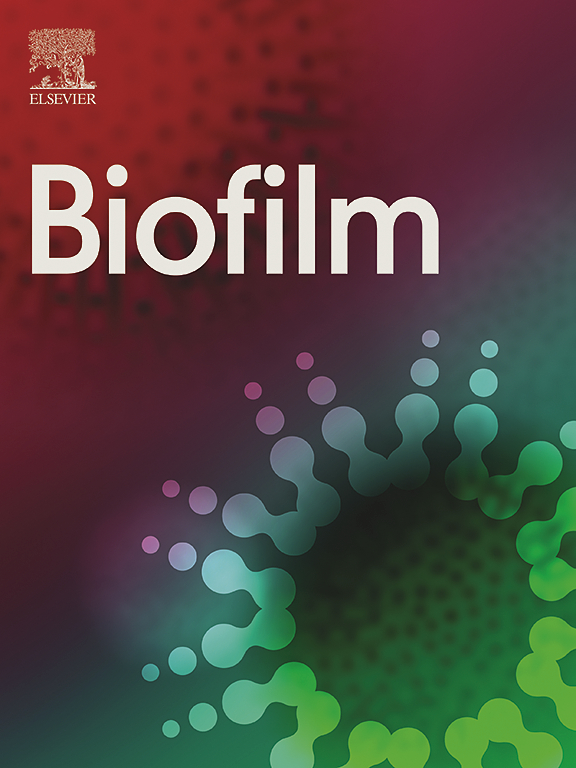Targeting Staphylococcus aureus biofilm-related infections on implanted material with a novel dual-action thermosensitive hydrogel containing vancomycin and a tri-enzymatic cocktail: in vitro and in vivo studies
IF 4.9
Q1 MICROBIOLOGY
引用次数: 0
Abstract
Implant-associated infections remain a critical challenge due to the presence of biofilm-forming bacteria, which enhance tolerance to conventional treatments. This study investigates the efficacy of a tri-enzymatic cocktail (TEC; DNA/RNA endonuclease, endo-14-β-d-glucanase, β-N-acetylhexosaminidase) targeting biofilm matrix components combined with supratherapeutic doses of antibiotics encapsulated in a thermosensitive hydrogel (poloxamer P407) for local administration. In vitro, the hydrogel formulation enabled controlled release of active agents over 12 h. Vancomycin and TEC co-formulated in hydrogel achieved up to 3.8 Log10 CFU count reduction and 80 % biofilm biomass reduction on MRSA biofilms grown on titanium coupons, demonstrating enhanced efficacy as compared to individual active agents, with 1.3–3.2 log10 additional killing. Fluoroquinolone efficacy remained unchanged by enzyme addition. In vivo, in a model of tissue cages containing titanium beads implanted in the back of guinea pigs, hydrogel-delivered vancomycin maintained therapeutic levels for seven days. Coupled with an intraperitoneal administration of vancomycin for 4 days, a single local administration of hydrogel containing both vancomycin and TEC was more effective than hydrogels containing either vancomycin or TEC, achieving an additional 2.1 Log10 CFU reduction compared to local vancomycin, 2.3 Log10 compared to local TEC, and 4.3 Log10 compared to systemic vancomycin treatment alone. However, partial regrowth occurred at later stages, indicating room for further optimization. Nevertheless, these findings already underscore the potential of combining a high dose of antibiotic with an enzymatic cocktail in a sustained-release hydrogel delivery system as a promising strategy for improving the management of biofilm-associated implant infections.
用一种新型的含有万古霉素和三酶混合物的双作用热敏水凝胶靶向植入材料上的金黄色葡萄球菌生物膜相关感染:体外和体内研究
由于生物膜形成细菌的存在,种植体相关感染仍然是一个关键的挑战,这增强了对常规治疗的耐受性。本研究探讨了三酶鸡尾酒(TEC;DNA/RNA内切酶,内切-14-β-d-葡聚糖酶,β- n -乙酰己糖苷酶)靶向生物膜基质成分,结合包裹在热敏水凝胶(poloxamer P407)中用于局部给药的超治疗剂量抗生素。在体外,水凝胶制剂能够在12小时内控制活性剂的释放。万古霉素和TEC在水凝胶中共配制,在钛片上生长的MRSA生物膜上达到3.8 Log10的CFU计数减少和80%的生物膜生物量减少,与单个活性剂相比,显示出更高的功效,额外杀死1.3-3.2 Log10。加酶后氟喹诺酮类药物的疗效不变。在体内,在豚鼠背部植入钛珠的组织笼模型中,水凝胶递送的万古霉素在7天内保持治疗水平。结合4天的万古霉素腹腔注射,单一局部给药含有万古霉素和TEC的水凝胶比含有万古霉素或TEC的水凝胶更有效,与局部万古霉素相比,CFU减少了2.1 Log10,与局部TEC相比,减少了2.3 Log10,与全身单独使用万古霉素相比,减少了4.3 Log10。然而,在后期出现了部分再生,这表明有进一步优化的空间。尽管如此,这些发现已经强调了将高剂量抗生素与酶混合物结合在缓释水凝胶递送系统中的潜力,作为改善生物膜相关植入物感染管理的有希望的策略。
本文章由计算机程序翻译,如有差异,请以英文原文为准。
求助全文
约1分钟内获得全文
求助全文

 求助内容:
求助内容: 应助结果提醒方式:
应助结果提醒方式:


